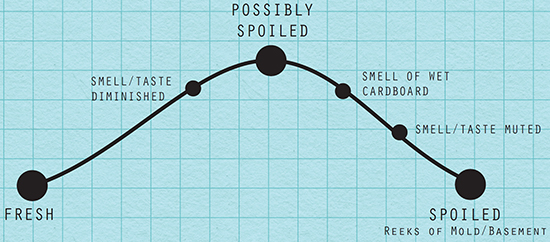
Whether at a restaurant or around your kitchen table, you should always take a moment to smell your wine to see if it is in good condition. Ask a casual drinker what spoiled wine smells like, and they will probably say “vinegar.” Who hasn’t inhaled the pungent, sour, and nutty aroma of wine you forgot to throw away? This, of course, is the sign your wine has oxidized—that is, it has been exposed to excessive amounts of oxygen.
The more common wine fault to look for, however, is the mildewy smell of wet newspaper, a basement floor, or, as I like to say, a waterlogged Toyota Corolla. This dank smell indicates that the wine is “corked,” or afflicted with a chemical that comes from a tainted cork or, less often, contamination on the production line at the winery. Along with the moldy smell, the wine itself will often taste flat and flavorless. This can happen to wine of any quality, so don’t just blame your sister’s bottle of 7-Eleven’s finest. In my experience, about 5 percent of wine suffers from cork taint.
Identifying cork taint is not like a trigonometry problem or a pregnancy test: The answer is not always clear-cut. When a wine exudes a fiercely dank cardboard-y smell, of course, you know you have a corked wine. But cork taint sometimes operates less conspicuously.
It is better to think of cork taint as a sliding scale, one in which there is sometimes only a whiff of basement-y stench. And, frustratingly, sometimes a corked wine is even harder to detect and only manifests itself in wine that is surprisingly devoid of aromas and flavor. Such subtlety stumps even experienced palates. When faced with the corked question, I will look for a second opinion and pass the glass to a tablemate or two, asking them if the wine seems off. In a restaurant, I will ask my server for confirmation, too, rather than rejecting the wine with Simon Cowellian cocksurety. The process becomes less confrontational when you give your server some ownership over the process, inviting him to smell and taste the wine, or take the bottle back to the sommelier or bartender to do so.
In certain instances, however, it is better to hold your fire. When I was recently at a celebratory dinner with a table full of casual drinkers, the waiter poured us a Cabernet Sauvignon that seemed corked. I thought about saying something until I observed that no one else seemed bothered by this corky cuvée. Corked wine will not hurt you, so why should I interrupt their merriment with the doleful notes of a Debbie Downer trombone? I quietly choked down a glass, happy to let ignorance be bliss.

OTHER FLAWS
OTHER WORRISOME FLAWS ARE SIGNALED BY A WHIFF OF:
• PRUNES, STEWED FRUIT: WINE IS “COOKED,” FROM EXPOSURE TO EXCESSIVE HEAT
• NUTTY, SHERRY-LIKE: WINE IS “OXIDIZED,” FROM EXPOSURE TO EXCESSIVE OXYGEN
• BAND-AIDS, UNPLEASANT BARNYARD: WINE IS “BRETTY,” FROM EXCESSIVE AMOUNTS OF THE YEAST BRETTANOMYCES)
• BURNT MATCHES/ROTTEN EGGS: SULFUR-RELATED FLAW.
ENEMY NUMBER ONE, HOWEVER, REMAINS THE MUSTY, MOLDY, SPIRIT-SLAYING STENCH OF CORK TAINT.